Export Related Articles
Michelin 2-Star Chefs Present Exquisite Korean Hanwoo Course
2024-11-08
.
Attached file
No attachmentsHits
32On November 4, the Hanwoo Board (President: Lee Dong-hwal) and the Ministry of Agriculture, Food and Rural Affairs hosted a Hanwoo fine dining event at Fritz in Kuala Lumpur, Malaysia. The event showcased a collaboration between Michelin 2-star chefs: Chef Lee Jun of SOIGNE and Chef Seo Hyun-min of Allen.
The goal of the event was to position Hanwoo (premium Korean beef) as a high-end meat choice in the Southeast Asian market. Influential Malaysian consumers and culinary experts were invited to experience the exceptional taste and quality of Hanwoo firsthand.
The Michelin-starred chefs prepared a six-course menu featuring dishes such as Hanwoo tartare, braised Hanwoo, and pan-fried battered Hanwoo.
Spanning appetizers to desserts, the menu highlighted various cuts of Hanwoo and other premium Korean ingredients.
Unique textures and rich flavors from eight different cuts—including round, rump round, and chuck roll—received an enthusiastic response from local gourmet enthusiasts.
The main course was the highlight, presenting grilled, salt-seasoned Hanwoo striploin and marinated, grilled Hanwoo top blade. Accompanied by rice prepared with dried vegetables and an assortment of Korean side dishes, the meal showcased the pinnacle of Korean cuisine.
Designed to harmonize flavors, the main course emphasized the distinctive savor of Hanwoo, allowing attendees to fully appreciate the inherent taste of premium Korean beef.
< Course menu introduction >
1. Hanwoo Tartare Yuk Hoe(Top inside round)
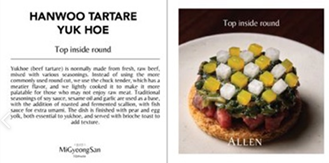
Yukhoe (beef tartare) is normally made from fresh, raw beef, mixed with various seasonings.
Instead of using the more commonly used round cut, we use the chuck tender, which has a meatier flavor, and we lightly cooked it to make it more palatable for those who may not enjoy raw meat. Traditional seasonings of soy sauce, sesame oil and garlic are used as a base, with the addition of roasted and fermented scallion, with fish sauce for extra umami.
The dish is finished with pear and egg yolk, both essential to yukhoe, and served with brioche toast to add texture.
2. Braise Hanwoo Jjim(Upper loin/Ribeye)
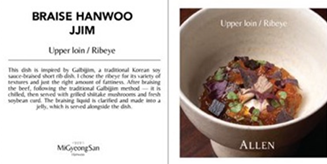
This dish is inspired by Galbijjim, a traditional Korean soy sauce-braised short rib dish.
I chose the ribeye for its variety of textures and just the right amount of fattiness.
After braising the beef, following the traditional Galbijjim method it is chilled, then served with grilled shiitake mushrooms and fresh soybean curd.
The braising liquid is clarified and made into a jelly, which is served alongside the dish.
3. Cold Cut Nang Chae(Tri tip)
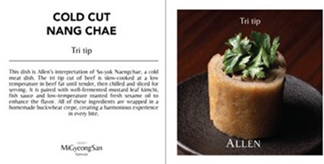
This dish is Allen's interpretation of Su-yuk Naengchae, a cold meat dish.
The tri tip cut of beef is slow-cooked at a low temperature in beef fat until tender, then chilled and sliced for serving.
It is paired with well-fermented mustard leaf kimchi, fish sauce and low-temperature roasted fresh sesame oil to enhance the flavor.
All of these ingredients are wrapped in a homemade buckwheat crepe, creating a harmonious experience in every bite.
4. Surf & Turf Mul Hoe(Clod/Shoulder)
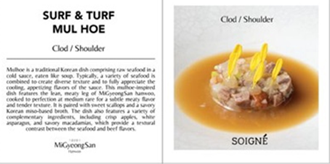
Mulhoe is a traditional Korean dish comprising raw seafood in a cold sauce, eaten like soup.
Typically, a variety of seafood is combined to create diverse texture and to fully appreciate the cooling, appetizing flavors of the sauce.
This mulhoe-inspired dish features the lean, meaty leg of MiGyeongSan hanwoo, cooked to perfection at medium rare for a subtle meaty flavor and tender texture. It is paired with sweet scallops and a savory Korean miso-based broth.
The dish also features a variety of complementary ingredients, including crisp apples, white asparagus, and savory macadamias, which provide a textural contrast between the seafood and beef flavors.
5.Hanwoo Tang Ban
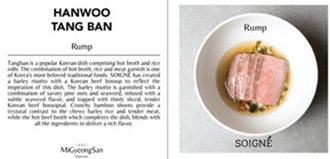
6. Yuk Jeon(Tenderloin)
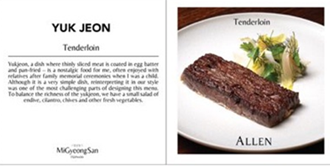
Yukjeon, a dish where thinly sliced meat is coated in egg batter and pan-fried is a nostalgic food for me, often enjoyed with relatives after family memorial ceremonies when I was a child.
Although it is a very simple dish, reinterpreting it in our style was one of the most challenging parts of designing this menu.
To balance the richness of the yukjeon, we have a small salad of endive, cilantro, chives and other fresh vegetables.
7. K-BBQ in Two Ways(Oyster Blade with Marinade)
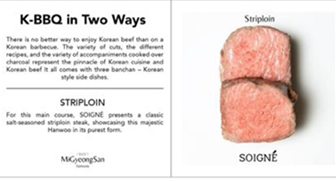

Beef marinated and grilled varies widely depending on the region.
I picked the most basic marinade of soy sauce and garlic, and instead of using the more common short ribs, I chose the flavorful oyster blade cut to offer something different.
After marinating the meat for about 10 hours, it was cooked twice-first at a low temperature, and then finished over charcoal.
8. Banchan
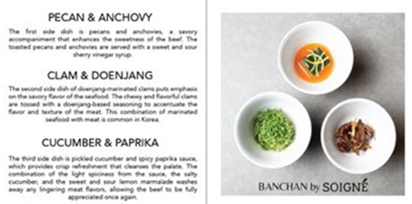
Pecan & Anchovy
The first side dish is pecans and anchovies, a savory accompaniment that enhances the sweetness of the beef.
The first side dish is pecans and anchovies, a savory accompaniment that enhances the sweetness of the beef.
The toasted pecans and anchovies are served with a sweet and sour sherry vinegar syrup.
Clam & Doenjang
The second side dish of doenjang-marinated clams puts emphasis on the savory flavor of the seafood.
The chewy and flavorful clams are tossed with a doenjang-based seasoning to accentuate the flavor and texture of the meat.
This combination of marinated seafood with meat is common in Korea.
Cucumber & Paprika
The third side dish is pickled cucumber and spicy paprika sauce, which provides crisp refreshment that cleanses the palate.
The third side dish is pickled cucumber and spicy paprika sauce, which provides crisp refreshment that cleanses the palate.
The combination of the light spiciness from the sauce, the salty cucumber, and the sweet and sour lemon marmalade washes away any lingering meat flavors, allowing the beef to be fully appreciated once again.
9. Rice

The accompanying rice is prepared with Korean dried sprouts, which impart a subtle bitterness and sweetness, complementing the rich, fatty flavors of the beef.
10. Hwa Chae
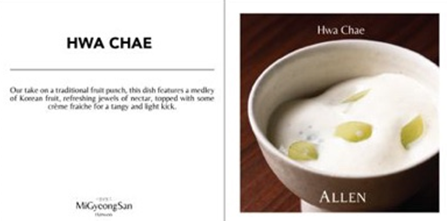
TOP









